
Santorini archipelago viewed from summit of Profitis Ilias (Stitched Panorama Image)
 |
|
Santorini archipelago viewed from summit of Profitis Ilias (Stitched Panorama Image) |
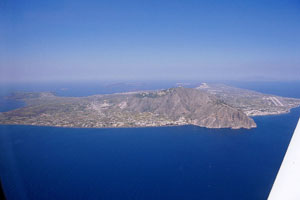 |
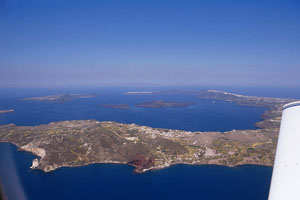 |
|
Aerial image of Santorini from SSE. Right of center is non-volcanic part of island. |
Aerial image of Santorini Caldera from south. Kameni islands are visible in center. |
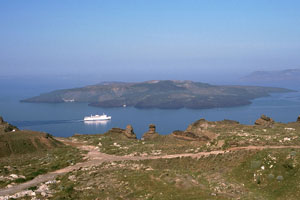 |
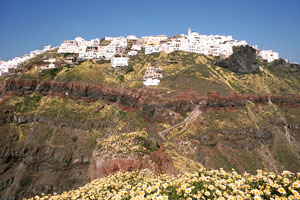 |
|
Ferry passing in front of Nea Kameni island |
Imerovigli village above caldera wall |
 |
 |
|
Fig.1 Map showing the strong regional influence of regional tectonics on the development of the volcanic field. Extracted from "Santorini Volcano". Geol. Soc. Lond., Memoirs 19, 165pp, Fig.3.57 d.o.i.:10.1144/GSL.MEM.1999.019.01.12; With kind permission of T.H. Druitt. |
Fig.2 Reconstruction of the four calderas of Santorini for which field evidence is preserved. Contours in meters. Extracted from "Santorini Volcano". Geol. Soc. Lond., Memoirs 19, 165pp, Fig.3.58; d.o.i.:10.1144/GSL.MEM.1999.019.01.12; With kind permission of T.H. Druitt. |
Plinian Eruption (Time B.P. ka*): |
Preceding Interplinian activity: |
Notes: |
Magma Types (B=Basalt; A=Andesite; D=Dacite; R=Rhyodacite) |
- |
Kameni lavas |
A |
|
Minoan (3.6) |
M12 (minor and localized deposits only) |
Caldera 4 formed; End cycle 2 |
R |
Cape Riva (21) |
M11, incl. Andesites of Oia / Therasia Lavas |
Caldera 3 formed |
R |
Upper Scoriae 2 (54) |
M10, incl. Megalo Vouno cinder cone, Skaros Lava shield |
M10 is thickest interplinian layer |
A |
Upper Scoriae 1 (70) |
M9 |
Caldera 2 formed |
A |
Vourvoulos (?) |
M8, incl. Columbos |
- |
A,D |
Middle Pumice (145) |
M7 |
- |
A,D |
Cape Thera (?) |
M6, incl. Simandiri Lavas |
- |
A |
Lower Pumice 2 (172) |
M5 |
Caldera 1 formed; End cycle 1 |
R |
Lower Pumice 1 (203) |
M4 |
- |
R |
Cape Therma 3 (?) |
M3, incl. Alonaki/NE-Lavas |
- |
A |
Cape Therma 2 (?) |
M2 |
Only Plinian eruption without documented PFs |
R |
Cape Therma 1 (?) |
M1 |
- |
A |
Table 1 - Summary of major eruptions of Santorini. * Dates vary considerably depending on source. Accuracy varies (standard deviation not shown). Based largely on Druitt et al. 1999.
|
Cliffs of Cape Aspronisi - Cycle 1 deposits visible under lighter Minoan deposits |
|
Beautifully stratified pre-Minoan deposits in W corner of Mavromatis pumice quarry |
|
"Red Beach" - Remains of cinder cone on Akrotiri Peninsula. Resulted from basaltic-andesitic strombolian activity. |
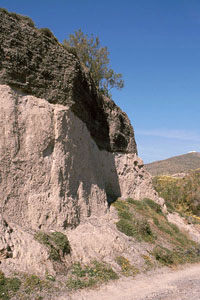 |
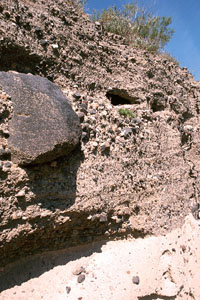 |
|
|
Layer 3 and Layer 4 deposits near Akrotiri |
Cliff formed by deposits on south coast by Akrotiri |
Large boulder embedded in layer 4 near Akrotiri |
|
Massive Minoan deposits on south coast, 1km east of Akrotiri |
|
Minoan deposits, Mavromatis pumice quarry |
Minoan deposits, Mavromatis pumice quarry |
|
Probable ballistic with impact sag, Mavromatis pumice quarry |
Minoan deposits, Mavromatis pumice quarry |
 |
|
Kameni Islands viewed from southwest (Stitched Panorama Image) |
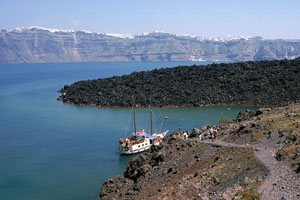 |
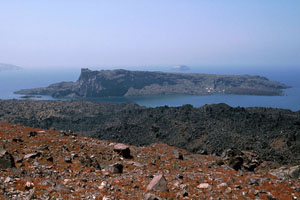 |
|
Landing site for tourist boats on Nea Kameni - Dark lava from 1866-1870 eruption in background |
View to Palea Kameni from center of Nea Kameni |
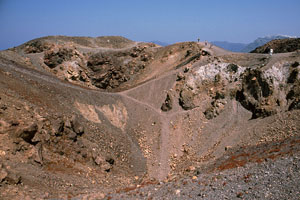 |
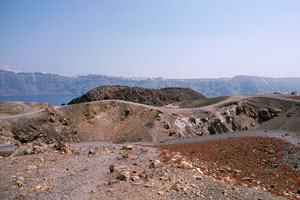 |
|
Recent crater on Nea Kameni |
Crater with dark lava dome over one of vents of 1866-1870 eruption behind |
|
Building at Fira quarry |
Decaying ship loading ramps below Fira quarry |
Massive deposits mined at Fira quarry |
|
Deposits of previous eruptions buried by Minoan pumice exposed at Fira quarry |
Top of sieve for size-sorting pumice, Fira quarry |
|
Decaying ship loading ramps below Fira quarry |
|
Decaying ship loading ramp below Fira quarry |
Quarry with ship-loading facility overlooking Athinios from north |
|
Mavromatis pumice quarry, view from SW |
Mavromatis pumice quarry with ship-loading facility |
Mavromatis pumice quarry, Minoan deposits |
|
Ruins of pumice storage facilities |
Remains of conveyor belts |
|
Fine pumice deposit at base of cliff |
Cliff with ash / pumice deposits of Minoan eruption |
Cliff with ash / pumice deposits of Minoan eruption |
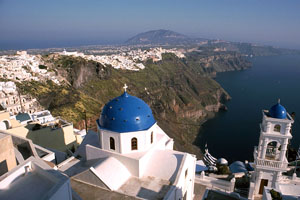 |
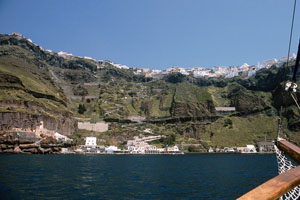 |
|
Main town of Fira perched on eastern caldera rim |
Thira port with Fira town above |
|
Various buildings |
Building with roof guttering |
|
Chamber with many storage vessels |
Various buildings |
|
Explanatory sign showing murals found at Akrotiri, now in museums |
Explanatory sign showing murals found at Akrotiri, now in museums |